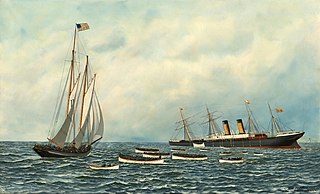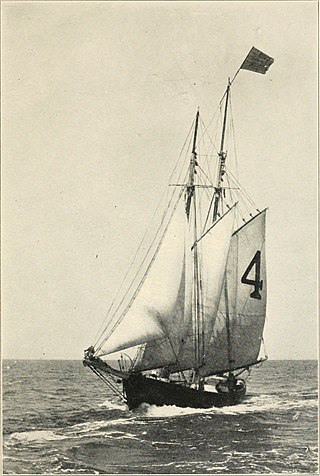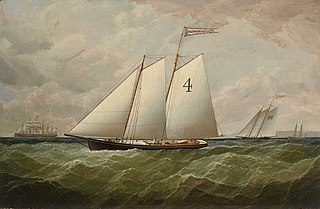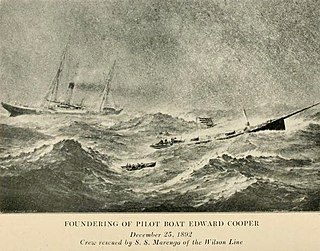
USS Hope was a 19th-century wooden yacht schooner, designed and built in 1861 by Henry Steers for Captain Thomas B. Ives of Providence, Rhode Island. She was acquired by the Union Navy during the American Civil War. She was placed into service as a gunboat assigned to support the fleet blockading the ports of the Confederate States of America. However, at times, Hope was assigned extra tasks, such as that of a dispatch boat, supply runner and salvage ship. She was a pilot boat from 1866 to 1891 and in 1891 she was replaced by the Herman Oelrichs, when the Hope was wrecked ashore the Sandy Hook Point.

Richard "Dick" Brown was a 19th-century Sandy Hook pilot. Brown was captain for the 19th-century Sandy Hook pilot boat Mary Taylor. At the time of his death he was the oldest of the Sandy Hook pilots having served for 50 years. He was the captain of the racing yacht America, which won the inaugural America's Cup in 1851.

James Dean Monroe Beebe was a 19th-century American Sandy Hook Pilot. He is known for being the oldest Sandy Hook-New Jersey pilot, having served for 55 years as a Sandy Hook pilot. He organized the New Jersey Sandy Hook Pilots Association.

The Sylph was a 19th-century pilot boat first built in 1834, by Whitmore & Holbrook for John Perkins Cushing as a Boston yacht and pilot-boat for merchant and ship owner Robert Bennet Forbes. She won the first recorded American yacht race in 1835. She was a pilot boat in the Boston Harbor in 1836 and 1837 and sold to the New York and Sandy Hook Pilots in October 1837. She was lost in winter of 1857 with all hands during a blizzard off Barnegat, New Jersey. The second Sylph was built in 1865 from a half-model by Dennison J. Lawlor. The third Sylph was built in 1878 at North Weymouth, Massachusetts for Boston Pilots. She was sold out of service in 1901, after 23 years of Boston pilot service.

The Phantom was a 19th-century Sandy Hook pilot boat built in 1867 from the designs by Dennison J. Lawlor. The schooner was considered a model for her type with a reputation for being very fast. She helped rescue the passengers on the steamship SS Oregon when it sank in 1886. She was one of the pilot-boats that was lost in the Great Blizzard of 1888. The Phantom was replaced by the pilot-boat William H. Bateman.

The Thomas S. Negus was a 19th-century two-masted Sandy Hook pilot boat, built by C. & R. Poillon shipyard in Brooklyn in 1873 for the New Jersey maritime pilots. She was built to replace the pilot boat Jane, No. 1, which sank in early 1873. She was the winner of a $1,000 prize at the Cape May Regatta in 1873. She was named for Thomas S. Negus, president of the N. J. Pilots' Commissioners. In 1897, she left the pilot service to prospect for gold during the Klondike Gold Rush.

James Funk was a 19th-century New York City pilot boat built in 1862 at Greenpoint, Brooklyn for a company of New York Pilots. She was built for speed. She was assigned the "Number 22," which was displayed on her mainsail. The James Funk was captured and burned by the Confederate raiding steamer CSS Tallahassee during the American Civil War. The Charlotte Webb was built in 1865 to take the place of the James Funk that was destroyed.

The Mary Taylor was a 19th-century yacht and Sandy Hook pilot boat, built at the Hathorne & Steers shipyard in 1849 for Captain Richard Brown. She was designed by George Steers with a new radical design with a long thin bow and wide stern, which made her faster than any other boat in her class. This design proved successful and led to the famous yacht America, which won the America's Cup in 1851. The Mary Taylor sank after colliding with the schooner Fairhaven in 1863. She was replaced by the Mary E. Fish.

The Widgeon was a 19th-century yacht and Sandy Hook pilot boat, built in 1855 by James R. & George Steers for Daniel Edgar of the New York Yacht Club and designed by George Steers. She came in 17th in an unsuccessful America’s Cup defense in 1870. Widgeon was sold in 1871 to a group of New York pilots to replace the John D. Jones, which sank in a collision with the steamer City of Washington. New York pilots condemned the Widgeon as unseaworthy in 1879, which sparked a fight for steam pilot-boat service. In 1883 a decision was affirmed by the Supreme Court and the Board of Commissioners of Pilots that pilot boats could be "propelled" by steam.

The Trenton was an auxiliary motor pilot boat built in Essex County, Massachusetts for a company of New Jersey Sandy Hook pilots in 1907. She was formerly the fishing schooner Kernwood, designed by Thomas F. McManus of Boston in 1904. As a pilot boat, she spent twenty-five years in pilot service before being placed out of service in 1934.

The David Carll was a 19th-century pilot boat, built in 1885 at the David Carll shipyard in City Island, New York. She was named in honor of David Carll, a well-known City Island shipbuilder. The David Carll was considered to be among the fastest schooners in the fleet. She was built to replace the Mary E. Fish that was run down and sank by the schooner Frank Harrington in 1885. She was one of the pilot boats that survived the Great Blizzard of 1888. The David Carll was lost at sea in 1893.

The Abraham Leggett was a 19th-century New York pilot boat built by Daniel Westervelt at the Westervelt & Co. shipyard. She helped transport New York City maritime pilots between inbound or outbound ships coming into the New York Harbor. In 1866, Pilot Michael Murphy was on the Abraham Leggett when the bark Emilie ran into the pilot boat. In 1879, the Abraham Leggett was hit and sank by the steamship Naples from Liverpool. She was replaced by the pilot boat Alexander M. Lawrence.

The Edward Cooper was a 19th-century Sandy Hook pilot boat, built in 1879 for New York Pilots at Greenpoint, Brooklyn. She was named in honor of the Mayor of New York City. The Edward Cooper helped transport New York City maritime pilots between inbound or outbound ships coming into the New York Harbor. She survived the Great Blizzard of 1888. In 1892, the Cooper sank in a snowstorm and was replaced by the Joseph Pulitzer in 1894.

Charlotte Webb was a 19th-century New York City pilot boat built in 1865 at the Webb & Bell shipyard to take the place of the James Funk, that was destroyed by the rebel Tallahassee during the Civil War. She survived the Great Blizzard of 1888, but was run down by the French steamship La Normandie in 1889. She was replaced by the pilot boat George H. Warren.
The James Gordon Bennett was a 19th-century two-masted pilot boat, built in 1870 at the Lawrence & Foulks shipyard. She was named in honor of James Gordon Bennett, Jr., publisher of the New York Herald. She went ashore in 1893 and was rebuilt at the C. & R. Poillon shipyard. In 1897, the James Gordon Bennett was bought by Miller J. Morse of the Atlantic Yacht Club and made into a yacht. He changed her name to Hermit. The New Jersey pilots purchased her in 1901, to replace the David T. Leahy, that was run down by the steamship Alene. The Hermit sank in 1906, when the steamship Monterey ran into her.

The Enchantress was a 19th-century Sandy Hook pilot boat built in 1851 by John Maginn who named her after one of the cast in the opera The Enchantress. She was launched from the Westervelt & McKay shipyard. The Enchantress was one of the oldest pilot-boats in the service. She was Cornelius Vanderbilt's favorite pilot boat. The Enchantress went down with all hands in the Great Blizzard of 1888. The pilot boat James Stafford was built to replace her.
The Yankee was a 19th-century Sandy Hook pilot boat built by Holbrook & Adams of Boston in 1848. The schooner was sold to New York pilots and used to pilot vessels to and from the Port of New York. In 1852 the crew of the Yankee received silver medals from the Massachusetts Humane Society for rescuing the captain and mate of the schooner Reaper. The Yankee struck an old wreck and sank 35 miles east of Sandy Hook in 1852. The Ellwood Walter was built to replace her in 1853.
The Blossom was a 19th-century Sandy Hook pilot boat built for the New York pilots around 1837. She helped transport maritime pilots between inbound or outbound ships coming into the New York Harbor. In 1839, she came across the Slave ship La Amistad. In 1840, there were only eight New York pilot boats, the Blossom being No. 5. Pilot Thomas Freeborn of the Blossom boarded the packet ship John Minturn and tried to guide the ship in bad weather. He was one of thirty-eight passengers that died near the Jersey Shore in 1846.

The Fleur de Lis was a 19th-century yacht and pilot boat built in 1865 by J. B. Van Deusen for Captain John S. Dickerson of the New York Yacht Club. She was bought by pilot Franklin B. Wellock and became the Boston pilot boat No. 7. She was known as one of the best pilot boats in the Boston harbor. By 1904, the pilot boat Fleur de Lis was lying in a graveyard for old boats in East Boston.

The Coquette was a 19th-century yacht and pilot boat, built in 1845 by Louis Winde, at the Winde & Clinkard shipyard in Chelsea, Massachusetts for yachtsmen James A. Perkins. Her design was based on a model by shipbuilder Dennison J. Lawlor. The Coquette was a good example of an early American yacht with a clipper bow. As a yacht, she won the attention for outsailing the larger New York yacht Maria at the second New York Yacht Club regatta in 1846. Perkins sold the Coquette to the Boston Pilots' Association for pilot service in 1848. She continued as a pilot boat until 1867 when she was sold as a Blackbirder to be used on the African coast.

















